This is a late bloomer, compared to staples such as rice and wheat. But oats are better for you than you know, says Swetha Sivakumar, in this week’s Sound Bites.

In 1994, Rickard Öste, professor emeritus with the department of food technology at Lund University, Sweden, invented an oat-based drink he called Oatly. It was meant as a milk substitute for the lactose-intolerant, and for nearly 20 years it remained a niche product.
Then, in 2014, Oatly’s new CEO Toni Petersson launched “the barista blend”. Company reps were sent to high-end coffee shops across New York City to convince baristas to recommend it to their customers. The baristas loved it because the plant-based milk had a rich texture that made frothing easier.
The brand became so successful, mainly via cafés, that it debuted its IPO on the Nasdaq valued at $10 billion, in 2021. The company has gone on to launch oat-based creamers, ice-cream, yoghurt. There’s talk of oat-based cheeses next.
The oat breakfast beyond Oatly, meanwhile, has evolved too. You can now buy oat groats, rolled oats, instant oats. All this starring a grain that was viewed with disdain for centuries. Samuel Johnson’s Dictionary of the English Language (1755) defined the oat as “A grain, which in England is generally given to horses, but in Scotland supports the people.” (The UK is one of the world’s largest consumers of oats today.)
Yes, oats are a late bloomer compared to staples such as rice and wheat. There’s a reason for this. Oats carry two to three times more fat than wheat. They contain a fat-digesting enzyme, lipase, that makes the grain go rancid quickly unless inactivated by heat treatment. It’s also a hard grain to cook. Whole groats (oats with just the husk removed) take up to four hours. Grinding the grain is an option, but that yields a pulpy porridge with an admittedly unlikeable texture.
One of the first breakthroughs in cooking time was achieved by chopping up groats using steel blades, a technique first used in 1877. Steel-cut oats cook in an hour. Another significant improvement came when the Nagel brothers (John and Henry, from Illinois) were able to produce oat flakes by pressing oat groats with rollers. This technique, invented in 1900, dropped the cook time to 10 minutes or less.
The thing about oats is that they’re really good for you, precisely because they are so hard to process. Unlike rice and flour, oats cannot have their fiber refined away. The oat grain does not break cleanly into bran, germ and endosperm. Food manufacturers (for once!) cannot separate it into its components. Oats remain technically wholegrain, even when steel-cut or chopped up. This means that they are able to retain their minerals (calcium, iron, magnesium, phosphorous, zinc etc) to a far greater degree.
Oats are also rich in soluble fibers called beta glucans, which are said to lower cholesterol levels in the body. One theory is that beta glucans do this by absorbing water to form a gel in the stomach. This gel acts like a net that traps bile and pushes it through the intestines and out of the body, preventing reabsorption. The body then makes up for the lost bile by converting existing cholesterol into bile. Beta glucans are also known to have anti-inflammatory properties, boost the growth of good gut bacteria and some studies suggest they may help lower the risk of heart disease.
Read: Know your oats: A glossary via Swetha Sivakumar
Meanwhile, unable to break down the grain, food technology has focused instead on ancillary products such as oat milk. This is good news too. Try making oat milk at home. The moment you heat it, it gets gooey and viscous. This is because of the presence of a starch called amylose, which gets thick and pasty when heated.
How does “barista oat milk” prevent this? Öste figured out that if enzymes were added to oat milk, they would break down the main starch components (amylose and amylopectin) into smaller carbohydrates such as… dextrin and glucose. As a bonus, they make the oat milk taste sweet with no added sweeteners.
Whichever way you cut it, oats are a sweet deal.
(To reach Swetha Sivakumar with questions or feedback, email upgrademyfood@gmail.com)
Enjoy unlimited digital access with HT Premium

Personalise your news feed. Follow trending topics
"oat" - Google News
September 17, 2022 at 07:16PM
https://ift.tt/Bp5xKV2
Oat couture: It’s a high score for the ultimate wholegrain - Hindustan Times
"oat" - Google News
https://ift.tt/zcTQAni
https://ift.tt/aUsYkgR
Bagikan Berita Ini














0 Response to "Oat couture: It’s a high score for the ultimate wholegrain - Hindustan Times"
Post a Comment